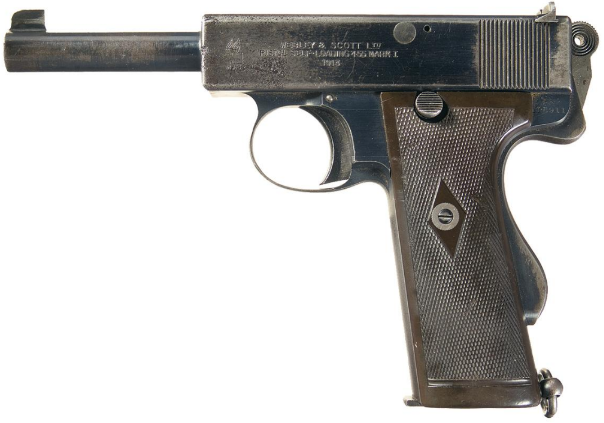The 455 Webley Auto was introduced in 1913 for Naval service in the Webley & Scott Self Loading Pistol Mark I, which was not intended to replace the Webley revolver, but to go on issue alongside it. The cartridge’s approval was later extended to Land service (mainly Royal Horse Artillery) and Air service. After the First World War, the cartridge’s use was restricted to RAF and Naval service. During the First World War, supplies of Webley Self Loading pistols were supplemented by quantities of Colt Government Model pistols, which were readily adaptable to the .455 WSL cartridge. The RAF continued to buy such Colt pistols in 1919. While the cartridge was well designed, it offered no advantage over the .45 ACP, so never achieved any degree of popularity outside British military circles. (IWM)
“Cartridge S.A. Ball Pistol Self Loading Webley & Scott .455 inch Mark I” was approved to design CIW1606 in April 1913 and shown in List of Changes Paragraph 16406 dated June 1913. “Webley & Scott” was later dropped from the title. In 1941 a nitrocellulose version of the cartridge was approved as “Cartridge S.A. Ball Pistol Self Loading .455 inch Mark Iz”. (Erlmeier, Brandt Ref. 468).























 Steel Dummy
Steel Dummy


This blackened case specimen might be a proof loading. The headstamp is still regarded as unknown. The rounds are odd in that they are loaded with Birmingham Metal and Munitions Co. Ltd. bullets (easily identified by ogive and a “B” on the base) and that on the “ball” rounds, the cases are always blackened. The current reasoning is that the “C” might well stand for “Colt,” since during that period, Colt made the Government Model Pistol for the British in caliber .455 Webley SL. Since that caliber of ammunition was not made in the U.S. Colt would have had to obtain any test material from England. Ball ammunition was not a problem. However, they would have needed proof loads (the proofing was done by British technicians, but at Colt, according to the terms of the contract) and functional dummies. While not a British marking, a blackened case was a typical U.S. marking for a proof load, and Colt may have required the American identification marking to avoid any chance of a mishap during testing. Since, again, these “C” rounds only appear as bulleted live cartridges with a blackened case, and as dummies, it is not unreasonable to believe that they were made specifically for Colt. The blackened-case “C” rounds have a very stiff charge of nitro-cellulose powder, not the normal fine cordite found in .455 of the era. British author and authority Ken Elks reckoned that the charge represented a 50% over-load in pressure. (IAA FORUM)

